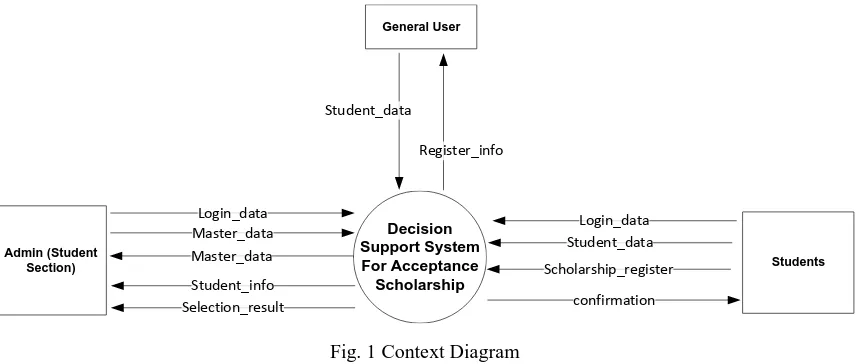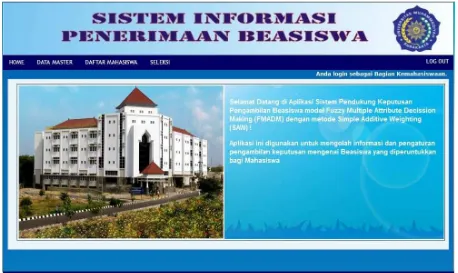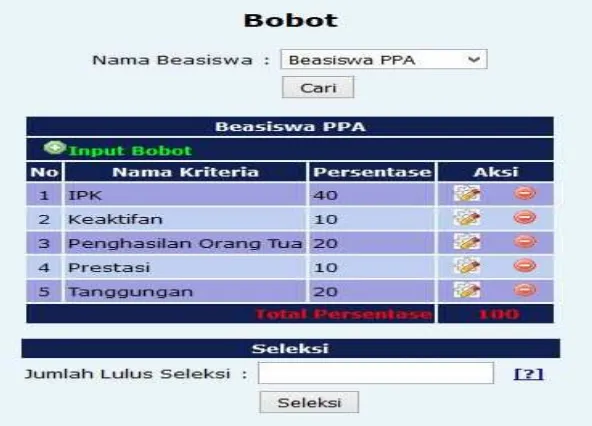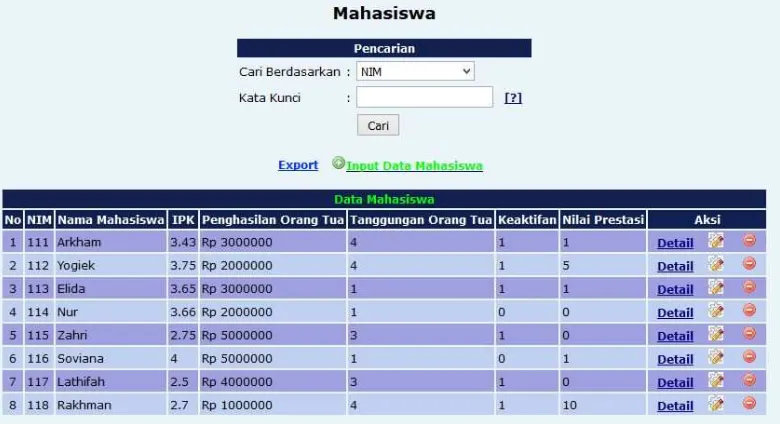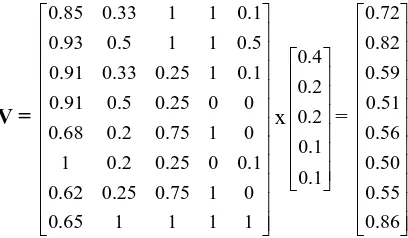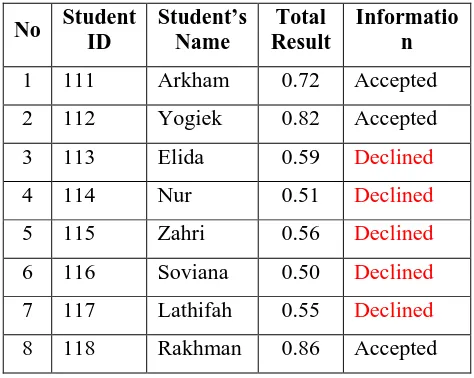DECISION SUPPORT SYSTEM FOR ACCEPTANCE
SCHOLARSHIP WITH SIMPLE ADDITIVE
WEIGHTING METHOD
Yogiek Indra Kurniawan
Universitas Muhammadiyah Surakarta
Pabelan, Kartasura, Surakarta, Central Java, Indonesia
Abstract
A large number of scholarships have been extensively distributed in the educational
institutions including college and university. It is, however, vulnerable to subjectivity. In
general, students applying for the scholarship will be selected by the committee that may be
subjective in the assessment process. In consequence, it can affect the result of scholarship
recipients. Decision Support System (DSS) is a computer-based information system that
supports the decision activities to be more. One method of the application of decision support
systems is Simple Additive Weighting (SAW). This study was exploring the application of
SAW in the case study of scholarship recipient selection process by weighting some
predetermined criteria.
Keywords: Scholarship, Decision Support System, Simple Additive Weighting, method.
Presenting Author’s biography
Yogiek Indra Kurniawan. Lecturer at Informatics Engineering from
Communication and Informatics Faculty in Universitas Muhammadiyah
Surakarta. Professional trainer that concern to information system
development and web based software development. Now, live in Surakarta,
Central Java, Indonesia.
I.
Introduction
Scholarships are frequently provided for the students of university who fulfill the specified criteria in accordance to the requirements. The number of students who apply for a scholarship would be a problem for management to determine which students are entitled to a scholarship. Several aspects will be used as parameters of including academic and non-academic achievements as well as the inability of students to afford the education fee in that university. However, the process to select the scholarship recipients in university is frequently carried out subjectively by Student Council or committee.
preferred due to its capability in sort out the optimal alternative from many alternatives, in this case the alternative refers to the students who are eligible to receive the scholarship based on certain criteria. This research was commenced by weighting the value of each attribute or criteria and ranking the alternatives. Decision support systems in this case study was made by using web-based programming language PHP with MySQL database. Web-based system was established since it is a flexible system which can be accessed by everyone anywhere and anytime.
II.
Decision Support System (DSS)
Decision Support Systems (DSS) is a computer-based system to facilitate the decision making process [1]. It is adaptive, interactive, flexible, and specifically developed to support the solution of unstructured problem to improve the quality of decision making. Hence, DSS can be defined as an adaptive, flexible, interactive computer-based system which is useful to solve unstructured problems and thereby increasing the value of the decisions [1].
III.
Simple Additive Weighting (SAW)
Simple Additive Weighting (SAW) method is often also known as term weighted summation method [2]. The basic concept from SAW is to find weighted summation rating performance of each alternative on all attributes. SAW method requires a process of normalizing the decision matrix (X) to a scale which can be compared with all the rating alternatives exist [2].
The steps in SAW are [3]:
a. Determining the criteria that will be used as a reference in the decision, namely Ci. b. Determining alternative weights on each criterion.
c. Making decisions based on criteria matrix (Ci)
d. Normalizing the matrix based on equations that are tailored to the type of attributes (attributes benefit or attribute costs) in order to obtain the normalized matrix R. The formula for determining the normalized matrix R are as follows :
=
attribute
cost
is
j
if
attribute
benefit
is
j
if
ij ij i
ij i
ij
ij
x
x
Min
x
Max
x
r
(1)e. Determining Final Value
To determine final results, use a value that is the value obtained from the ranking process is summation of the normalized R matrix multiplication with the weight vector in order to obtain the greatest value will be selected as the best alternative (Ai) as a solution. Preference value for each alternative (Vi) is given as:
Vi =� w����
�
�=1 (2)
Vi value larger indicates that Ai is chosen alternative.
IV.
Analysis and Discussion
IV.1 Determination of Criteria
Several aspects as the critera in the assessment system are as follows:
C1 = Grade Point Average (GPA) C2 = Parent’s Earnings
C3 = The number of Parent’s dependent C4 = Active In Organizations
C5 = Achievement
Each scholarship can be determined weight or percentage of each criterion based on the type and needs of scholarships. For example, some of scholarships have a tendency to assign a higher weight to criteria cumulative grade point (GPA). Meanwhile, some scholarships have a tendency to assign a higher weight to the criteria of parents’ income and number of parent’s dependent.
There are several steps taken to obtain judgment in determining which students will be given scholarships nor recommended for obtaining a scholarship are as follows :
1. Determine the weight on each criteria, in order to obtain the matrix W
2. Create an alternative table that contains the value of each criteria of each individual student who asked to receive scholarships
3. Perform the process of normalizing the decision matrix (X) to a scale by comparing the value of all ratings alternatives. At this stage will be generated matrix R that contains normalized performance rating of each student on the attributes of the established criteria.
4. Calculate the value of the preference for each alternative (Vi) (matrix V) by multiplying matrix R with matrix W
5. Set the recommended students to obtain scholarships
IV.2 System Design
In this system design, a model of the proposed system is presented in modeling logic. This model will describe the data flow diagrams early (Diagram Context), which will explain to the user how will the functions proposed system of logic will work.
Diagram context for this decision support system are as follows :
Decision Support System For Acceptance
Scholarship
Students Admin (Student
Section)
Student_data
General User
Student_data
Register_info
Scholarship_register confirmation Master_data
Master_data Student_info Selection_result
Login_data
Login_data
Fig. 1 Context Diagram
V.
Implementation
Here implementation of Decision Support System for acceptance scholarships based design that has been proposed :
V.1 Functionality
The following is a list of the functionality of a decision support system with simple additive weighting method built :
Tab. 1 List of Application’s Functionality
No User Functionality
1. General User Register
2. Student – Admin
(Student Section) Login
3. Student View profile
4. Student Edit profile
5. Student Register fo scholarship
6. Student View scholarship has been registered
7. Student Delete scholarship has been registered
8. Admin (Student Section) Manage user data (Insert, Update, Delete, View, and Search user data)
9. Admin (Student Section) Manage scholarship data (Insert, Update, Delete, View, and Search scholarship data)
10. Admin (Student Section) Manage criteria data (Insert, Update, Delete, View, and Search criteria data)
11. Admin (Student Section) Manage student data (Insert, Update, Delete, View, and Search student data)
12. Admin (Student Section) Register scholarship from student
13. Admin (Student Section) Delete scholarship registered by student
14. Admin (Student Section) Weight criteria setting for each scholarship (Insert, Update, Delete and View criteria for each scholarship)
15. Admin (Student Section) Selection scholarship acceptance by SAW Method
16. Admin (Student Section) View detail selection
17. Admin (Student Section) Scholarship’s report
18. Admin (Student Section) Student’s report
19. Admin (Student Section) Report of scholarship register by student
20. Admin (Student Section) Acceptance scholarship’s report
=
1 . 0
1 . 0
2 . 0
2 . 0
4 . 0
W
Fig. 2 Schoolarship Application
V.2 Evaluation
Here is an example of the data entered in the system as well as the calculations performed by the system with a simple additive weighting method. Steps 1-5 as described in the previous section will be explain.
1. Determine the weight on each criteria, in order to obtain the matrix W C1 = Grade Point Average (GPA)
C2 = Parent’s Earnings
C3 = The number of Parent’s dependent C4 = Active In Organizations
C5 = Achievement
For each criteria, we can give weight in percentage, such as : C1 = 40%
C2 = 20%
C3 = 20% (3)
C4 = 10%
C5 = 10%
Fig. 3 Weight on Each Criteria on Application
2. Create an alternative table that contains the value of each criteria of each individual student who asked to receive scholarships.
Suppose that there are eight students who signed up to receive a scholarship with criteria data as shown by Table 2. From 8 students below, will be determined three students eligible for scholarship.
Tab. 2 List of Applicant
No Student
ID Name GPA
Parent’s Earnings
The number of
Parent’s dependent
Active In
Organizations Achievement
1 111 Arkham 3.43 Rp 3.000.000 4 1 1
2 112 Yogiek 3.75 Rp 2.000.000 4 1 5
3 113 Elida 3.65 Rp 3.000.000 1 1 1
4 114 Nur 3.66 Rp 2.000.000 1 0 0
5 115 Zahri 2.75 Rp 5.000.000 3 1 0
6 116 Soviana 4 Rp 5.000.000 1 0 1
7 117 Lathifah 2.5 Rp 4.000.000 3 1 0
8 118 Rakhman 2.7 Rp 1.000.000 4 1 10
Fig. 4 List of Applicant on Application
3. Perform the process of normalizing the decision matrix (X) to a scale by comparing the value of all ratings alternatives. At this stage will be generated matrix R that contains normalized. performance rating of each student on the attributes of the established criteria.
=
attribute
cost
is
j
if
attribute
benefit
is
j
if
ij ij i ij i ij ij
x
x
Min
x
Max
x
r
• For GPA criteria, the activity of the organization, and achievement is an profits attribute, because higher GPA from student, more active in organization and more achievement received, make bigger possibility of student to be elected.
• parents income and number of dependents is a cost attribute because higher Parent’s earnings and more parent’s dependent, make getting smaller possibility of student to be elected.
So, from student data above, we can make calculation bellow :
85 0 4 43 3 7 2 5 2 4 75 2 66 3 65 3 75 3 43 3 43 3 11 . . ) . ; . ; ; . ; . ; . ; . ; . max( . = = = r 93 0 4 75 3 7 2 5 2 4 75 2 66 3 65 3 75 3 43 3 75 3 21 . . ) . ; . ; ; . ; . ; . ; . ; . max( . = = = r 91 0 4 65 3 7 2 5 2 4 75 2 66 3 65 3 75 3 43 3 65 3 31 . . ) . ; . ; ; . ; . ; . ; . ; . max( . = = = r
And so on.
= 1 1 1 1 65 0 0 1 75 0 25 0 62 0 1 0 0 25 0 2 0 1 0 1 75 0 2 0 68 0 0 0 25 0 5 0 91 0 1 0 1 25 0 33 0 91 0 5 0 1 1 5 0 93 0 1 0 1 1 33 0 85 0 . . . . . . . . . . . . . . . . . . . . . . . R
[image:8.595.195.399.411.530.2]Here is Matrix R on aplication :
Fig. 5 Matrix R on Application
4. Calculate the value of the preference for each alternative (Vi) (matrix V) by multiplying matrix R with matrix W
V = 1 1 1 1 65 0 0 1 75 0 25 0 62 0 1 0 0 25 0 2 0 1 0 1 75 0 2 0 68 0 0 0 25 0 5 0 91 0 1 0 1 25 0 33 0 91 0 5 0 1 1 5 0 93 0 1 0 1 1 33 0 85 0 . . . . . . . . . . . . . . . . . . . . . . . x 1 0 1 0 2 0 2 0 4 0 . . . . . = 86 0 55 0 50 0 56 0 51 0 59 0 82 0 72 0 . . . . . . . .
[image:8.595.112.505.565.706.2]Here is screenshoot of multiplying matrix R with matrix W on application :
Fig. 6 Multiplying Matrix R with Matrix W on Application
Tab. 3 Selection Result from SAW Method
No Student
ID
Student’s Name
Total Result
Informatio n
1 111 Arkham 0.72 Accepted
2 112 Yogiek 0.82 Accepted
3 113 Elida 0.59 Declined
4 114 Nur 0.51 Declined
5 115 Zahri 0.56 Declined
6 116 Soviana 0.50 Declined
7 117 Lathifah 0.55 Declined
8 118 Rakhman 0.86 Accepted
Here is screenshoot of final result on application :
Fig. 7 Final Result on Application
VI.
Conclusion
1. Decision Support System Model with Simple Additive Weighting (SAW) method was evidenced to be useful and valid in the case of scholarship recipient selection process.
2. In applying Simple Additive Weighting (SAW) method, the assessment criteria and their respective weighting should be determined in advance to obtain the final score of each candidates by is using matrix multiplication.
References
[1] Ekasari, and Husnul. Perancangan Sistem Pendukung Keputusan untuk Memantau Kualitas Lingkungan. 2010.
[3] S. Kusumadewi, S. Hartati, A. Harjoko, and R. Wardoyo. Fuzzy Multi-Attribute Decision Making (FUZZY MADM). Yogyakarta : Penerbit Graha Ilmu. 2006.
